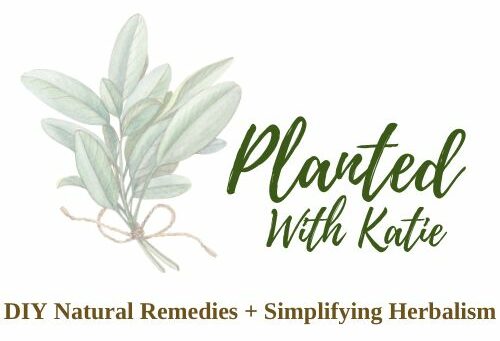How To Smoke Herbs (With 3 Herbal Smoking Blends)
Smoking herbs, especially when crafted into herbal smoking blends, isn't just about recreation – it can be a journey towards therapeutic benefits. Let's explore How To Smoke Herbs safely, plus 3 beginner-friendly herbal smoking blends to try.

Disclaimer: This is not medical advice. Information and statements shown here are for educational and informational purposes only and are not to replace the advice of your healthcare professional. We are not condoning or suggesting smoking herbs, simply providing up-to-date safety and helpful advice information.
This post may include affiliate links. Please refer to our disclaimer for full disclosure.
In this blog post, we'll explore the world of herbal smoking blends, emphasizing the belief that herbs play a positive role in overall well-being. Before delving into the "how-to," let's acknowledge the long history of using herbs in different cultures, from the Native Americans to Traditional Chinese Medicine practitioners.
When it comes to smoking herbs, it's not about replacing tobacco cigarettes but creating your own smoking blend. This allows you to control what goes into it, steering clear of toxic chemicals found in traditional cigarettes. Now, let's consider some key components:
Pros and Cons of Smoking Herbs
Let's get straight to it – smoking herbs can have both potential benefits and drawbacks. Here's the lowdown:
Potential Health Benefits
- Ancient Wisdom in Modern Times:
- Throughout history, diverse cultures, from Native Americans to practitioners of Traditional Chinese Medicine, have harnessed the therapeutic potential of herbs. It's a tradition that continues today.
- Mindful Smoking for Well-being:
- Crafting your herbal smoking blend allows you to be mindful of what you're inhaling. Using a base herb like marshmallow leaf can create a light smoke, and adding flavorful options such as rose petals or lemon balm not only pleases your palate but may offer additional benefits.
- Support for Specific Health Concerns:
- Some herbs, like red raspberry leaf or uva ursi, bring more to the table than just flavor. They've been associated with potential benefits, from supporting the respiratory system to addressing menstrual cramps.
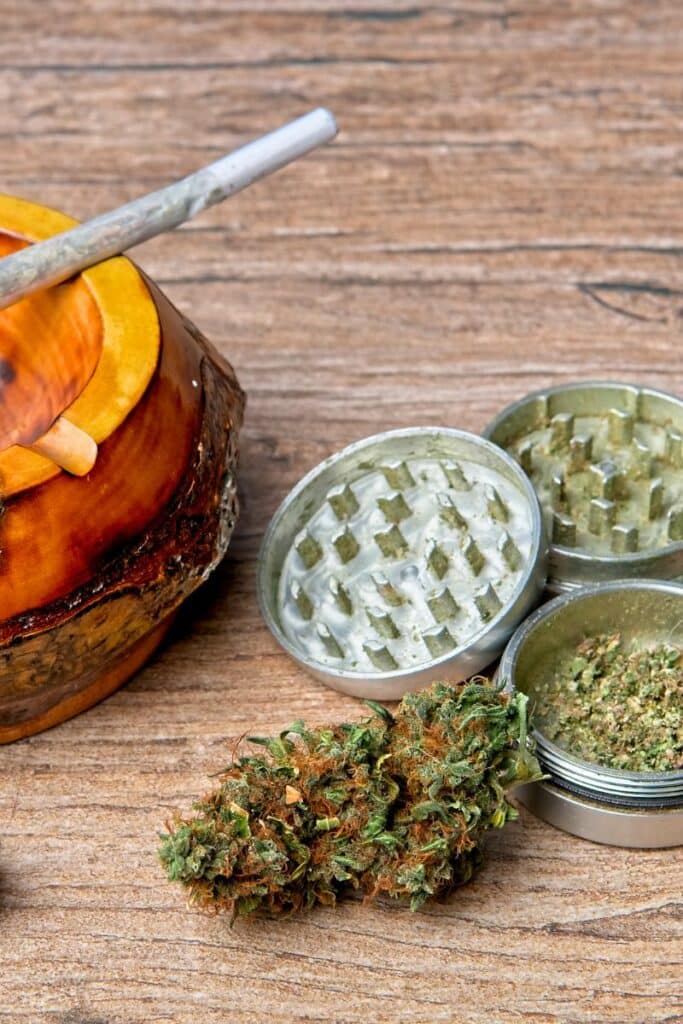
Acknowledging Concerns and Drawbacks
- Mind the Smoke – Health Risks:
- It's crucial to acknowledge that inhaling any type of smoke, even from herbal blends, isn't risk-free. The combustion process produces carbon monoxide, and while herbal smokes may have fewer toxic chemicals than traditional cigarettes, they aren't entirely without risks.
- Moderation is Key:
- Smoking anything, even herbs, poses potential risks. Small amounts and moderation are emphasized to minimize negative effects. Consider alternatives like herbal spliffs or herbal joints, and always be aware of your health.
- No Such Thing as a Perfect Smoke:
- While herbal smoking blends offer a more natural alternative, there's no such thing as a risk-free smoke. Being informed about the potential drawbacks is crucial for making mindful choices.
In the end, it's about finding a balance that works for you. If you choose to explore herbal smoking blends, do it with your eyes open, understanding both the potential benefits and the associated concerns.
How to Smoke Herbs
Now, let's get down to the nitty-gritty – how to turn those carefully chosen herbs into a smoking experience worth savoring. Remember, it's all about moderation and mindfulness.
8 Steps to Smoking Herbs
- Select Your Base Herb:
- Choose a base herb, like marshmallow leaf, for a smooth and light smoke. This will be the foundation of your herbal smoking blend.
- Add Flavor with Supporting Herbs:
- Enhance the experience by adding flavorful herbs like rose petals or lemon balm. This not only tantalizes your taste buds but could potentially contribute to your well-being.
- Mindful Preparation:
- Ensure your herbs are dry and well-blended. Use a closed container to preserve freshness and prevent moisture buildup.
- Craft Your Own Herbal Smoking Blend:
- Experiment with different herbs to create your signature blend. It's like crafting a unique piece of art – except it's for your senses.
- Moderation is Key:
- Whether you're rolling your own herbal joint or packing a pipe, use small amounts. Remember, the aim is a pleasant experience, not a heavy cloud of smoke.
- Choose Your Smoking Method:
- From herbal spliffs to traditional pipes, there are various ways to enjoy your blend. Find what suits you best.
- Mind Your Health:
- Understand that any kind of smoke, even from herbal blends, involves inhaling carbon monoxide. Consider alternatives like vaporization if you're particularly mindful of your lung health.
- Stay Hydrated:
- Have a little water handy. Smoking can be dehydrating, and staying hydrated is always a good choice.
Remember, the key is to enjoy the process and the result in moderation. So, go ahead, create your own herbal masterpiece, and let the smoke carry you into a world of flavor and relaxation.
- Have a little water handy. Smoking can be dehydrating, and staying hydrated is always a good choice.
How to Make Your Own Herbal Smoking Blend
Crafting your own herbal smoking blend is more than just a process – it's an art. It allows you to curate an intentional and enjoyable experience. Let's dive into the DIY guide:
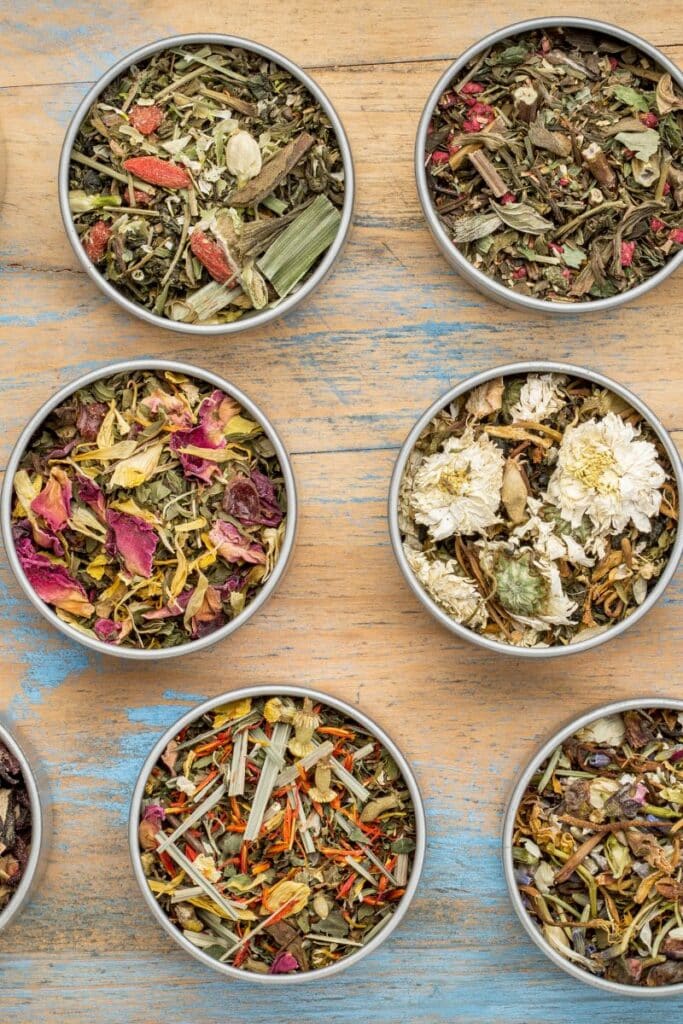
Step-by-Step Guide To Crafting Your Own Herbal Smoke Blend
Start with a Base Herb
The main ingredient, often referred to as the base herb, forms the foundation of your blend. Consider herbs like marshmallow leaf or red raspberry leaf for a medium smoke. Adding a flavoring herb like rose petals or lemon balm can enhance the taste.
Add Supporting Herbs for Flavor
Some herbs, like uva ursi or chocolate mint, contribute not only to the flavor but also bring potential health benefits. From supporting the respiratory system to alleviating menstrual cramps, these herbs offer more than just a pleasant smoking experience.
Experiment with Different Herbs
The beauty lies in experimentation. Try different herbs to find your favorite combination. It's your blend, crafted to suit your preferences.
Mindful Measurements – Small Amounts
Less is often more. Use small amounts of each herb to maintain a balanced and enjoyable smoking experience.
Preserve Freshness in a Closed Container
Store your blend in a closed container to maintain freshness and prevent moisture. This ensures the longevity of your herbal creation.
Consider Health Impacts – Choose Alternatives
Be mindful of potential health impacts. Remember, any form of smoke involves inhaling carbon monoxide. Consider alternative methods like vaporization for a potentially gentler experience.
Remember, this exploration is not to promote smoking but to provide information for educational purposes. As you embark on creating your own herbal smoking blends, let's keep in mind the essence of herbs contributing positively to our well-being.
10 Herbs to Consider When Smoking
Creating your own herbal smoking blend opens a world of possibilities. Here's a list of diverse herbs, each bringing its unique flavor and, according to traditional wisdom, potential benefits.
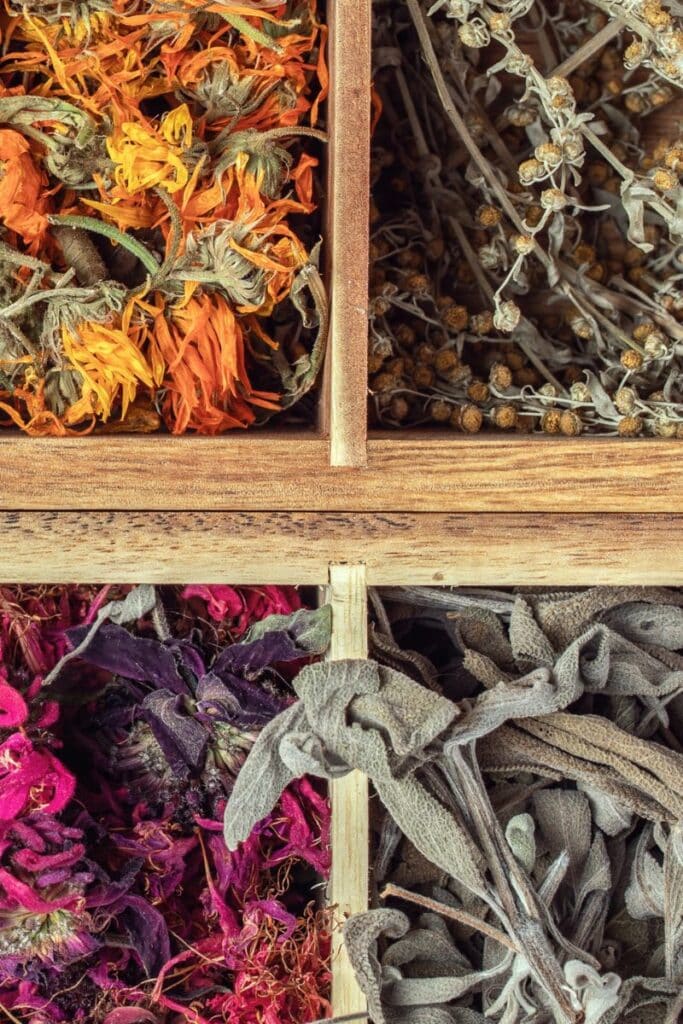
- Marshmallow Leaf (Althaea officinalis):
- Base Herb
- Potential Benefits: Smooth, light smoke; historically used for respiratory health.
- Blue Lotus (Nymphaea caerulea):
- Supportive Herb
- Potential Benefits: Thought to induce relaxation and enhance the overall smoking experience.
- Rose Petals (Rosa spp.):
- Flavoring Herb
- Potential Benefits: Adds a floral touch; traditionally associated with calming properties.
- Damiana (Turnera diffusa):
- Supportive Herb
- Potential Benefits: Damiana, scientifically known as Turnera diffusa, is renowned for its mild, relaxing properties. Has also been found to give an aphrodisiac effect.
- Lemon Balm (Melissa officinalis):
- Flavoring Herb
- Potential Benefits: Citrusy and uplifting; may contribute to stress relief.
- Red Raspberry Leaf (Rubus idaeus):
- Supportive Herb
- Potential Benefits: Often used for its potential benefits for the female reproductive system.
- Uva Ursi (Arctostaphylos uva-ursi):
- Base Herb
- Potential Benefits: Traditionally associated with urinary health.
- Mullein (Verbascum thapsus):
- Supportive Herb
- Potential Benefits: Mullein, historically utilized for various purposes like lung health, brings a unique character to your blend.
- Chocolate Mint (Mentha x piperita 'Chocolate'):
- Flavoring Herb
- Potential Benefits: Adds a sweet and refreshing flavor; may aid digestion.
- Blue Cornflower Petals (Centaurea cyanus):
- Flavoring Herb
- Potential Benefits: Aesthetically pleasing; traditionally used for eye health.
Herbs to Avoid When Smoking
While the world of smokable herbs is diverse, not all herbs are suitable for smoking. Here's a list of herbs to steer clear of when crafting your herbal smoking blends:
- Tobacco (Nicotiana tabacum):
- Reason to Avoid: While commonly used in cigarettes, the risks associated with tobacco, including carbon monoxide exposure, are well-documented.
- Salvia Divinorum:
- Reason to Avoid: This herb, traditionally used for introspective experiences, may not be suitable for casual smoking due to its potent effects.
- White Sage (Salvia apiana):
- Reason to Avoid: While often used in supportive roles, smoking white sage can release compounds that may irritate the respiratory system.
- Essential Oils:
- Reason to Avoid: In their concentrated form, essential oils can be harsh on the lungs when smoked. It's safer to explore other forms of aromatherapy.
- Herbs with Toxic Compounds:
- Reason to Avoid: Some herbs contain toxic compounds that may be harmful when inhaled. Do thorough research before adding a new herb to your blend.
- Unknown or Unverified Herbs:
- Reason to Avoid: Herbs without a well-documented history of use or clear safety information should be approached with caution.
Smoking herbs should enhance, not harm, your well-being. Always prioritize your health and choose herbs with a known history of safe use. Remember, the joy of smoking herbs lies in the harmonious blend of flavors, not in taking unnecessary risks.
3 Beginner-Friendly Smoking Blends
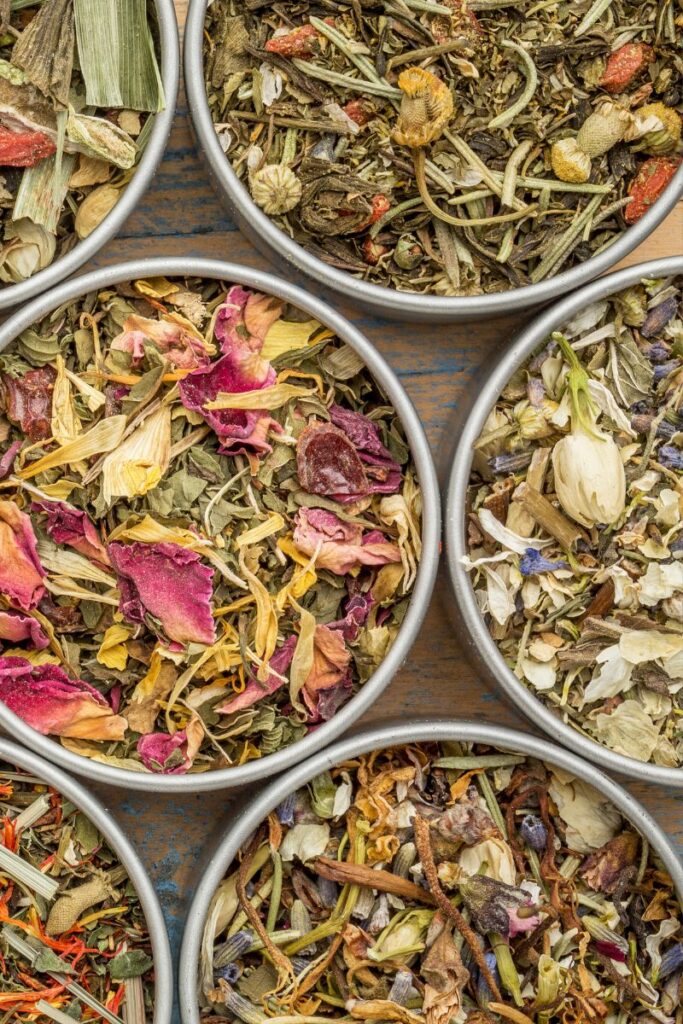
Embarking on your herbal smoking journey? Here are three herbal smoke blends perfect for beginners, offering not just flavor but potential health benefits.
1. Soothing Floral Blend:
Imagine strolling through a fragrant garden. This blend not only delights your senses but may have soothing effects on your nervous system, creating a moment of tranquility.
- Base Herb: Marshmallow Leaf
- Supportive Herb: Blue Lotus
- Flavoring Herb: Rose Petals

Citrusy Mint Fusion
This blend brings a burst of citrusy mint. Lemon balm and red raspberry leaf may even contribute to easing menstrual cramps, making it a medicinal choice. And who doesn't want a hint of chocolate during a menstrual cycle?
- Base Herb: Lemon Balm
- Supportive Herb: Red Raspberry Leaf
- Flavoring Herb: Chocolate Mint

Balancing Earthy Blend
Visualize a serene forest. This blend, rooted in ancient traditions, offers an earthy experience. Uva Ursi is believed to support the respiratory system, adding a layer of health-conscious choice.
- Base Herb: Uva Ursi
- Supportive Herb: White Sage
- Flavoring Herb: Salvia Divinorum

What Do You Wrap Herbs in to Smoke?
When it comes to wrapping herbs for smoking, options abound. Let's explore choices that consider both health and the environment, and suggest alternatives for those steering clear of traditional rolling papers.
- For the Traditionalists
- Consideration: While widely used, traditional rolling papers may contain additives.
- Alternative Suggestion: Opt for unbleached or hemp papers for a more natural choice.
- The Eco-Friendly Twist
- Consideration: Choose leaves from edible plants, like banana or corn husks.
- Alternative Suggestion: Embrace a zero-waste approach by using naturally derived wrappers.
3. Herbal Spliffs
- Infuse Flavor, Minimize Toxins
- Consideration: Combine your herbs with herbal smoking blends for a flavorsome experience.
- Alternative Suggestion: Experiment with herbal spliffs, blending your favorite herbs for a unique smoke.
4. Vaporizers
- A Modern Twist
- Consideration: Vaporizers heat herbs without combustion, minimizing exposure to harmful substances.
- Alternative Suggestion: Consider investing in a vaporizer for a cleaner smoking experience.
5. Pipe or Bong
- Classic and Practical
- Consideration: Pipes and bongs offer a direct way to smoke herbs.
- Alternative Suggestion: Ensure your pipe or bong is made from safe materials like glass or ceramic.
3 Environmental and Health Tips to Consider
- Store your herbs in a closed container to preserve freshness.
- Experiment with different wrapping options to find what suits you.
- Explore eco-friendly options like recycled paper or hemp-based materials.
Conclusion
As we finish talking about herbal smoking, keep things simple and smart. When making your herb blends, be careful with what you use to stay safe. Believe in herbs' good side for relaxation and flavor, but take it slow and steady.
The journey is about finding joy in trying new things, always making sure it's good for you. Remember, keep it moderate and enjoy the rich world of herbal smoking responsibly.
